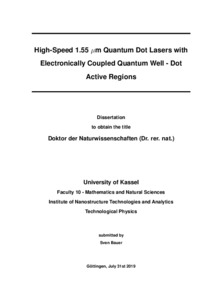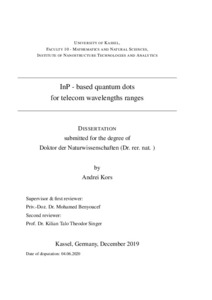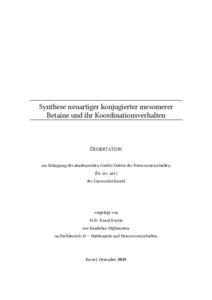Suche
Anzeige der Dokumente 1-4 von 4
Dissertation

 High-Speed 1.55 µm Quantum Dot Lasers with Electronically Coupled Quantum Well - Dot Active Regions
High-Speed 1.55 µm Quantum Dot Lasers with Electronically Coupled Quantum Well - Dot Active Regions
(2019-07-31)
The expansion of long-distance data communication at a wavelength of 1.55 µm calls for larger data transfer rates. Consequently, an improvement of emission and modulation properties of lasers emitting in this wavelength region is of high interest. The utilization of so-called tunnel-injection (TI) structures in InP-based quantum dot (QD) lasers is promising to fulfill this task. The aim of this thesis was the realization and analysis of TI structures in the lattice matched InP material system and incorporation into ...
Dissertation

 1.55 μm Quantum Dot Lasers for Telecommunication
1.55 μm Quantum Dot Lasers for Telecommunication
(2019)
The thesis at hand investigates the suitability of quantum dot (QD) material for use in long-distance coherent communication. The thesis was written in the frame of the SASER project MONOLOP that is aiming for a compact, monolithically integrated light source with a tunable wavelength covering the C+-band and narrow spectral linewidth below 500 kHz.
The thesis reviews the theoretical background of quantum dot material based on the InP material system and distributed feedback (DFB) lasers with lateral gratings as ...
Dissertation
 InP - based quantum dots for telecom wavelengths ranges
InP - based quantum dots for telecom wavelengths ranges
(2019-12)
Long-distance quantum communication applications require sources of single photons, emitting at telecom wavelengths (around 1550 nm) with minimum attenu-ation losses of silica fiber.
Semiconductor self-assembled InAs/InP-based quantum dots (QDs) are possible candidates to
reach this spectral region. One of the challenges on the way is a QD asymmetry, which limits the fidelity of entangled photons. Therefore, morphological and optical properties of QDs should be improved in order to achieve the necessary quality and ...
Dissertation
 Synthese neuartiger konjugierter mesomerer Betaine und ihr Koordinationsverhalten
Synthese neuartiger konjugierter mesomerer Betaine und ihr Koordinationsverhalten
(2019-12)
Lange Zeit galten Carbene als transiente Spezies, deren Labilität bzw. hohe Reaktivität gegen eine Isolierbarkeit in Substanz sprach. Erst nach der richtungsweisenden Entdeckung durch ARDUENGO et al., die ein stabiles freies Carben kristallin erhalten konnten, wurden mehr und mehr stabile Carbene isoliert. Das ARDUENGO-Carben gehört zu der Klasse der N-heterocyclischen Carbene (NHCs). Die Stabilität solcher Carbene wird durch zwei Aminosubstituenten am CCarben-Atom und des Weiteren durch die Eingliederung dieses ...




